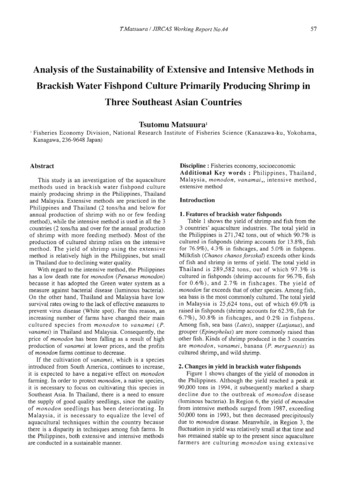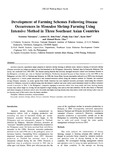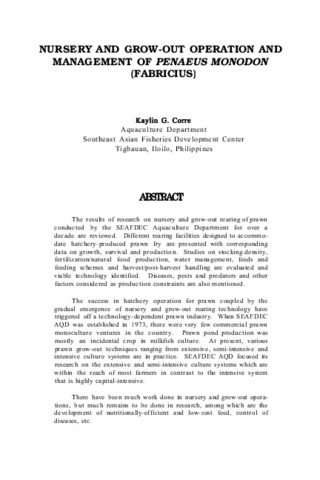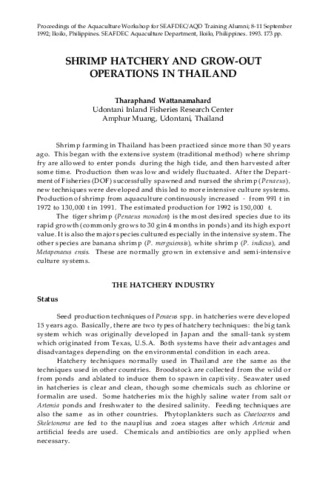Analysis of the sustainability of extensive and intensive methods in brackish water fishpond culture primarily producing shrimp in three Southeast Asian countries

ရှာဖွေ/ဖွင့်ပါ။
ရက်စွဲ
2006စာရေးသူ
Page views
514
Share
စိတ္တဇ
This study is an investigation of the aquaculture methods used in brackish water fishpond culture mainly producing shrimp in the Philippines, Thailand and Malaysia. Extensive methods are practiced in the Philippines and Thailand (2 tons/ha and below for annual production of shrimp with no or few feeding method), while the intensive method is used in all the 3 countries (2 tons/ha and over for the annual production of shrimp with more feeding method). Most of the production of cultured shrimp relies on the intensive method. The yield of shrimp using the extensive method is relatively high in the Philippines, but small in Thailand due to declining water quality.
With regard to the intensive method, the Philippines has a low death rate for monodon (Penaeus monodon) because it has adopted the Green water system as a measure against bacterial disease (luminous bacteria). On the other hand, Thailand and Malaysia have low survival rates owing to the lack of effective measures to prevent virus disease (White spot). For this reason, an increasing number of farms have changed their main cultured species from monodon to vanamei (P. vanamei) in Thailand and Malaysia. Consequently, the price of monodon has been falling as a result of high production of vanamei at lower prices, and the profits of monodon farms continue to decrease.
If the cultivation of vanamei, which is a species introduced from South America, continues to increase, it is expected to have a negative effect on monodon farming. In order to protect monodon, a native species, it is necessary to focus on cultivating this species in Southeast Asia. In Thailand, there is a need to ensure the supply of good quality seedlings, since the quality of monodon seedlings has been deteriorating. In Malaysia, it is necessary to equalize the level of aquacultural techniques within the country because there is a disparity in techniques among fish farms. In the Philippines, both extensive and intensive methods are conducted in a sustainable manner.
ဘာသာရပ်
Taxonomic term
စုစည်းမှုများ စုစည်းမှုများ
Related items
Showing items related by title, author, creator and subject.
-
Development of farming schemes following disease occurrences in monodon shrimp farming using intensive method in three Southeast Asian countries
Matsuura, Tsutomu; de la Peña, Leobert D.; Ean, Chee Phaik; Siow, Ryon; Alias, Ahmad Husin (Japan International Research Center for Agricultural Sciences, 2007)All three countries experienced major progress in intensive shrimp farming at different ties. Intensive farming of monodon shrimp (Penaeus monodon, an indigenous species) was first launched by the Philippines, followed by ... -
Nursery and grow-out operation and management of Penaeus monodon (Fabricius)
Corre, Kaylin G. (Aquaculture Department, Southeast Asian Fisheries Development Center, 1988)The results of research on nursery and grow-out rearing of prawn conducted by the SEAFDEC Aquaculture Department for over a decade are reviewed. Different rearing facilities designed to accommodate hatchery-produced prawn ... -
Shrimp hatchery and grow-out operations in Thailand
Wattanamahard, Tharaphand (Aquaculture Department, Southeast Asian Fisheries Development Center, 1993)Shrimp farming in Thailand has been practiced since more than 50 years ago. This began with the extensive system (traditional method) where shrimp fry are allowed to enter ponds during the high tide, and then harvested ...






